Attached files
| file | filename |
|---|---|
| EX-99.1 - EX-99.1 - EQT Corp | a19-1335_2ex99d1.htm |
| 8-K - 8-K - EQT Corp | a19-1335_28k.htm |
The New New EQT Company, New Leadership, New Focus Q4 volumes exceed guidance midpoint by ~20 Bcfe Q4 development CapEx in-line with prior guidance MM(1) Forecasted Q4 Free Cash Flow of ~$100 ~$350MM of Adjusted Free Cash Flow(1) in Transition from growth mode to manufacturing mode 2019 Focus on optimized lateral length, $2.7B+ of Adjusted Free Cash Flow(1) over next five years spacing, and operating cadence the Increase operating efficiency and lower costs (1)Non-GAAP financial measure, see appendix for definition Note: 2019 Adjusted Free Cash Flow uses pricing as of 01/14/2019; beyond 2019 pricing assumes $2.85 NYMEX for Henry Hub and ($0.45) local basis 2 Generate Sustainable Free Cash Flow Q4 2018 Performance Back on Track

EQT’s Transformation Into the Leading U.S. Natural Gas Producer Our leadership transition and complex transformation is now behind us 1 3 5 7 9 the Board named Rob President and CEO June 2017 November 2017 February 2018 March 2018 April 2018 July 2018 August 2018 November 2018 December 2018 6 8 2 4 World Class Sustainable Asset Base Free Cash Flow Financial Strength 3 TheNew Completed spin-off of Equitrans Midstream, creating the third largest natural gas gatherer in the U.S. Rob McNally assumed President and CEO role Four new independent Directors added to Board Completed streamlining transactions Chairman assumes interim CEO position Completed merger, forming the largest North American natural gas producer (>4 Bcfe/d) After an intensive search, McNally as the next Announced streamlining of midstream partnerships: EQM, RMP, and EQGP Announced plan to separate the upstream and midstream businesses Announced merger with Rice Energy Launched COO search and formed Operating and Capital Efficiency Board Committee

The New EQT: Strong Fundamentals to Deliver Shareholder Value World-class asset base, sustainable free cash flow and financial strength Low leverage of 2.2x Net Debt / Adjusted EBITDA (1)Assumes 1,000’ spacing and 12,000’ lateral (2)Non-GAAP financial measure, see appendix for definition (3)Based on EQT’s estimated 12/31/2018 Net Debt divided by forecasted 2019 Adjusted EBITDA. Net Debt means consolidated total debt, less consolidated cash and cash equivalents (4)ETRN share price as of 12/31/2018 4 World-Class Asset Base Leading U.S. natural gas producer at >4.0 Bcfe per day 680,000 core net Marcellus acres / 1,950 undeveloped locations(1) / 15-20 year drilling inventory Contiguous acreage position allows for longer laterals and efficient long-term development Sustainable Free Cash Flow Evolution of strategic intent: volume growth FCF & returns Current plan generates Adjusted Free Cash Flow(2) of ~$350 MM in 2019, $2.7 B+ 2019-2023 Execute plan and transition to stable operations to drive development and cost efficiencies Falling capital requirements with moderate growth, high-graded wells, shallower base declines, and volume curtailment mitigation Financial Strength Investment grade credit ratings (2,3) 19.9% retained equity stake in Equitrans Midstream worth $1.0 B at current share price(4)

Substantial Position Well-positioned to deliver in the Core of the Core sustainable free cash flow from our world-class asset base EQT Acreage Overlays the SW Marcellus Core Market Cap(1) $ 4.8 B Data sets include >4,000 wells in the Marcellus and >1,000 wells in the Utica Utica Cumulative Production Heat Map Ownership Interest in ETRN(3) $ 1.0 B Core Marcellus Undeveloped Locations(4,5) 1,950 2017 Proved Undeveloped Reserves 10.1 Tcfe 2019E Production 1,470 – 1,510 Bcfe (1)As of 12/31/2018 (2)Enterprise value is calculated utilizing EQT closing share price and estimated Net Debt as of 12/31/2018 (3)Market value as of 12/31/2018 of 19.9% of ETRN shares outstanding (4)Acres and locations as of 12/31/2018 (5)Assumes 1,000’ spacing and 12,000’ lateral (6)Includes 41 Bcfe related to 2018 divestitures (7)Non-GAAP financial measure, see appendix for definition Marcellus Core Utica Core EQT Acreage 5 Heat map generated using IHS public data for all operators – depicts 24-month cumulative Mcfe normalized for lateral length 2019E Adjusted EBITDA(7) $2.4 – 2.5 B 2018E Production(6) 1,488 Bcfe 2017 Proved Developed Reserves11.3 Tcfe Core Net Marcellus Acres(4) 680,000 SW Marcellus Cumulative Production Heat Map Pittsburgh Metro Area Enterprise Value(2) $10.2 B

Consolidated Core Position Top-tier dry, wet and rich gas Marcellus assets SW Marcellus Heat Map / Core Acreage EQT’s core acreage consistently yields average EURs(1) Data sets include >4,000 wells in the Marcellus of 2.4 Bcfe / 1,000’ Best rock yields EURs > 3.0 Bcfe / 1,000’ Strong results from new development these core boundaries further delineating mulative Reference: Year 1 cumulative type Dry Gas: 501 Mcfe/ft Wet Gas: 465 Mcfe/ft curve yield(2) Wells umulative est ad – 1 Well 365 Day Cum Production (Dry Gas) 365 Day Cum Production (Wet Gas) 700 800 700 600 500 400 300 200 100 - umulative 600 500 Cumulative 400 300 200 100 Cumulative - Kevech Pad River Pad Dry IR Curve BIG177 Pad PUL96 Pad WEU 4 Pad Wet IR Curve ut Test Green HHililllPPaadd (1)”EUR” means estimated ultimate recovery. See appendix for cautionary statements related to EUR EQT Acreage BTU line Marcellus Core (2)Based on 12,000’ Marcellus well; curtailed at 18 MMcfe/d (1.5 Mcfe/d/ft) Heat map generated using IHS public data for all operators – depicts 24-month cumulative Mcfe normalized for lateral length Note: Wells shown are at ~800’ lateral spacing 6 Mcfe / ft Mcfe / ft Pittsburgh Metro Area Kevech Pad – 7 1 Year Avg Cu Production = 617 Wells Mcfe/ft River Pad – 2 90 Day C Production = 147 Step-out T Mcfe/ft. BIG177 P 1 Year Cu Production = 21% Li mulative 679 Mcfe/ft.; quids Green Hill Pad – 1 Year Avg C Production = 596 7 Wells Mcfe/ft WEU4 Pad 1 Year Avg Production = 28% Li – 5 Wells 571 Mcfe/ft.; quids PUL96 Pad 1 Year Avg Production = 29% Li Step-o – 10 Wells 387 Mcfe/ft.; quids

The New EQT: The Next Phase of Our Transformation Our plan to generate sustainable free cash flow and shareholder value Action Item Measure Timeline Implement plan to reduce capital costs by 10% (“Target 10%” Initiative) Q4 2019 1 and years of oil and gas operating experience 2 Q1 2019 and well development costs 3 (1)ETRN share price as of 12/31/2018 (2)Non-GAAP financial measure, see appendix for definition 7 Execution and Improvement Deliver on 2019 plan and execute 5-year planIn Process Mitigate volume curtailments2019 / 2020 Hire External Chief Operating Officer Identifying shortlist of highly qualified candidatesIn Process Actively working to complete search processQ1 2019 Execution Operational Improvement Creation of Operating and Capital Efficiency Board Committee Comprised of four former upstream executives with over 125 combinedQ4 2018 Restructuring and Early Cost Reductions Identified ~$100 MM of annual reductions in G&A, capitalized overhead Reduce Leverage and Return Capital to Shareholders Equity stake in Equitrans worth $1.0 B at current share price(1) Reduce leverage to target of <2.0x Net Debt / Adjusted EBITDA(2)2019 – 2020 Return incremental free cash flow to shareholders

2019 Plan Supports Near-Term Free Cash Flow 1 Flow in 2019(1) Approximately $350 MM of Adjusted Free Cash Net Development Activity (Turned in Line) Sales Volumes (Bcfe) 1,470 – 1,510 Adjusted Operating Cash Flow ($B)(1) $ 2.2 – 2.3 Adjusted Free Cash Flow ($B)(1) $ 0.3 – 0.4 Reserve Development $ 1.6 Capitalized Overhead 0.1 Tophole Rigs 2 – 4 Frac Crews 5 – 7 Total Capital Expenditures $ 1.9 – 2.0 (1)Non-GAAP financial measure, see appendix for definitions (2)Other CapEx includes interest, engineering, geology, IT, facilities, vehicles and compliance 8 Other(2)0.1 Horizontal Rigs6 – 8 Activity2019E 2019E: 24 WV Marcellus Land0.2 Capital Expenditure Detail ($B)2019E 2019E: 100 SWPA Marcellus 2019E: 23 Utica Capital Expenditures ($B)$1.9 – 2.0 Adjusted EBITDA ($B)(1)$2.4 – 2.5 Operational and Financial Detail2019E

Improvements in Capital Efficiency: 2018E vs. 2019E Reserve Development 1 Stabilized scheduling and focus on operational efficiencies drive 2019 improvements Total D&C CapEx Cost per Foot ($/ft.)(1) Spud and Turned-in-line Average Lateral Length (ft.)(1) Spud TIL 12,100 $1,125 11,600 $934 $150 2018 E 2019 E 2018 E 2019 E Total Reserve Development CapEx ($B)(1,2) $2.3 Reserve Development $ 2.3 $ 1.6 $0.3 Capitalized Overhead 0.1 0.1 Total Capital Expenditures $ 2.7 $ 1.9 – 2.0 2019 E 2018 E (1)Represents all well phases and development areas. See appendix for details (2)Total reserve development includes approximately $145 MM and $135 MM of pad construction and pad facilities costs for 2018 and 2019, respectively (3)Other CapEx includes interest, engineering, geology, IT, facilities, vehicles and compliance 9 Other(3) 0.10.1 Land0.20.2 $1.6 2018 Operational Missteps Capital Expenditure Detail ($B)2018E2019E 10,600 8,400 2018 Operational Missteps
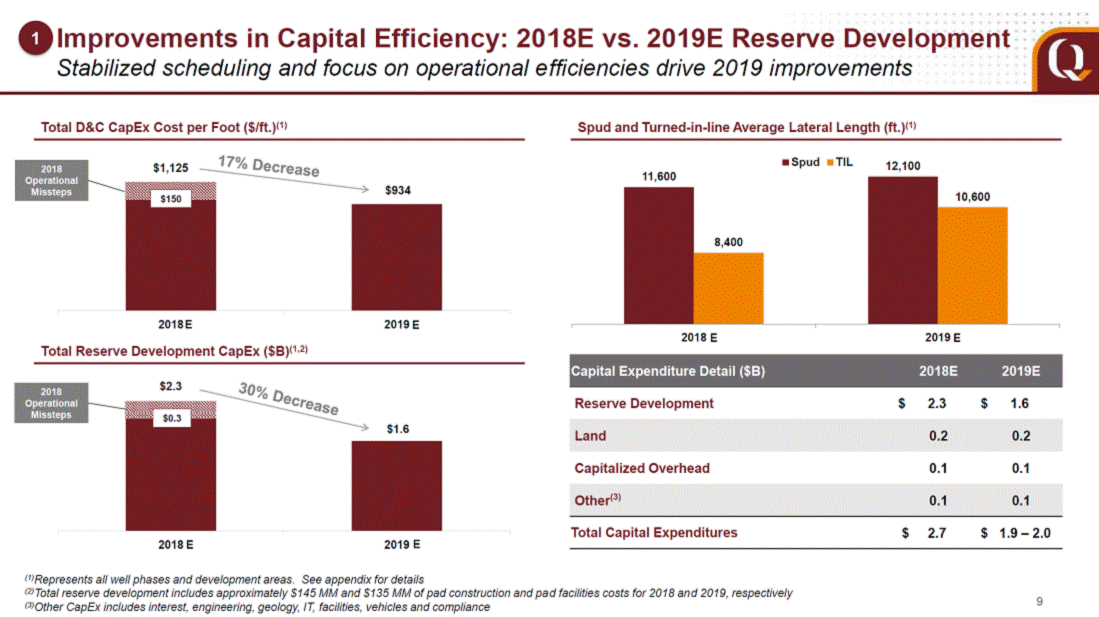
Detailed Enhanced 2019 Development and CapEx Plan 1 transparency, accountability and results 160 140 120 100 80 60 40 20 - 14,000 13,000 12,000 11,000 10,000 9,000 8,000 7,000 6,000 5,000 4,000 PA Marcellus WV Marcellus OH Utica Total Program Spud Well Count TIL Well Count Spud Avg. Lateral Length TIL Avg. Lateral Length 10 (1)Total D&C CapEx excludes ~$135 MM in pad construction and pad facility costs Net Well Count Average Lateral Length (ft.) 2019E Activity PA Marcellus WV Marcellus OH Utica Total Program Total D&C CapEx ($MM)(1) $990 $170 $270 $1,430 Spud Average Lateral (ft.) 13,200 6,500 11,200 12,100 TIL Average Lateral (ft.) 11,300 6,200 12,200 10,600 147 126 100 91 24 23 20 15
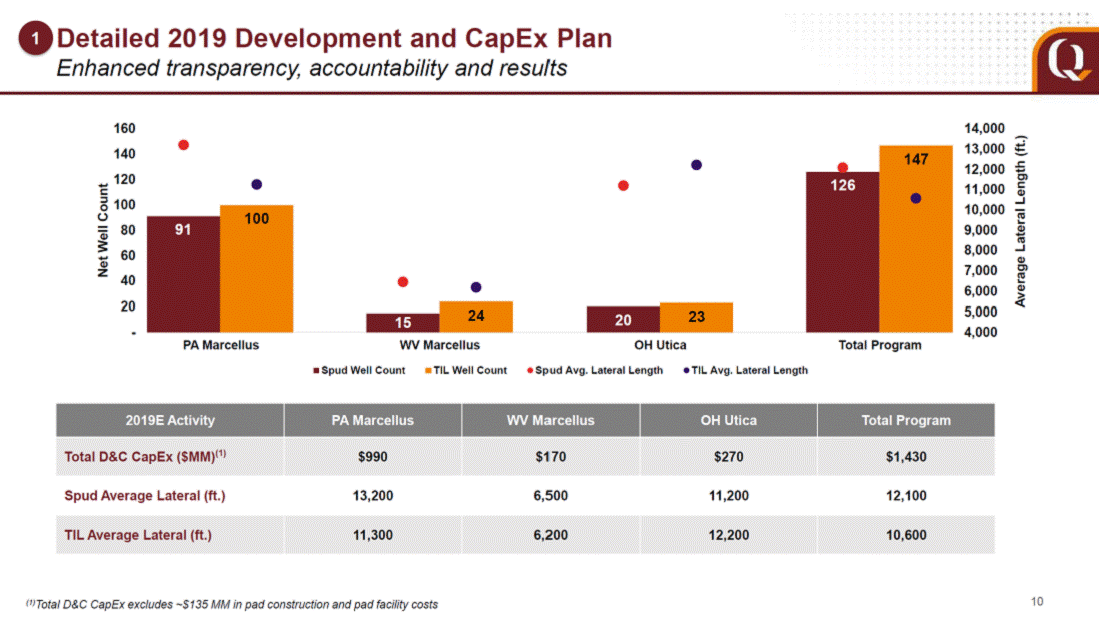
Development Efficiencies and Optimization 1 Increasing lateral lengths and optimizing spacing generates higher single-well returns Increasing lateral well spacing optimizes reservoir development Higher well costs resulting from larger completion jobs Cost increases offset by enhanced EURs and returns Results in more efficient capital deployment Targeting optimal well spacing of 1,000 feet ~75% of planned 2019 PA spuds are at 850-950 foot spacing ~20% of planned 2019 PA spuds are > 950 foot spacing Historical Average Spacing (ft.) - PA Marcellus Wells (Spud) 880 840 2019E (2) 2016 2017 2018 Delivering Enhanced Value to Shareholders (1)IRR based on $2.50/Dth realized price, D&C CapEx as shown in table and midpoint of 2019E unit cost guidance (less transmission) (2)EQT’s 2019 PA Marcellus wells (spud) are expected to average 880’ spacing, 13,200’ lateral length, and D&C costs of ~$870/ft. 11 740760 Incremental Development Efficiencies vs 700’ Spacing Well Spacing (ft.) EUR (Mcfe/ft.) Cost $/Foot $/Mcfe BTAX IRR 700 Base Base Base Base 750 5% 2% -3% 6% 800 10% 4% -5% 8% 850 15% 6% -7% 12% 900 20% 8% -10% 14% 950 25% 11% -12% 16% 1,000 30% 13% -13% 18% Core PA Marcellus - 13,000' Lateral Well Spacing (ft.) EUR (Mcfe/ft.) Cost $/Foot $/Mcfe BTAX IRR(1) 700 2,182 $810 $0.371 49% 750 2,291 $827 $0.361 52% 800 2,400 $844 $0.352 53% 850 2,509 $861 $0.343 55% 900 2,618 $878 $0.335 56% 950 2,727 $895 $0.328 57% 1,000 2,836 $913 $0.322 58%

5-Year Financial and Operating Plan 1 B(1) Generates cumulative Adjusted Free Cash Flow of ~$2.7 160 15,000 140 14,000 120 100 13,000 12,000 80 11,000 60 40 10,000 9,000 20 0 8,000 2019 2020 2021 2022 2023 TIL Avg. Lateral Length Spud Well Count TIL Well Count Spud Avg. Lateral Length increase cumulative (1) (1)Non-GAAP financial measure, see appendix for definitions (2)Other CapEx includes interest, engineering, geology, IT, facilities, vehicles and compliance (3)2019E includes ~$90 MM of dividends received from ETRN and ~$100 MM of cash tax refund; 2020E includes ~$80 MM of dividends received from ETRN and ~$50 MM of cash tax refund Note: 2019 uses pricing as of 01/14/2019; beyond 2019 pricing assumes $2.85 NYMEX for Henry Hub and ($0.45) local basis ; 2020E-2023E sales volume represents midpoint of expected results 12 Net Well Count Average Lateral Length (ft.) Execution of “Target 10%” initiative will Adjusted Free Cash Flow to ~$3.4 B (2019–2023) 2019E 2020E2021E2022E2023E Sales Volumes (Bcfe) 1,470 - 1,510 1,5701,6501,7301,820 Adjusted Operating Cash Flow ($B)(1) $2.2 – 2.3 $2.0$2.1$2.1$2.4 Reserve Development CapEx ($B) Land CapEx ($B) Cap Overhead + Other CapEx ($B)(2) 1.6 0.2 0.2 1.41.21.11.3 0.20.20.20.2 0.10.10.10.1 Total CapEx ($B) $1.9 - 2.0 $1.7$1.5$1.4$1.6 Adjusted Free Cash Flow ($B)(1,3) $0.3 – 0.4 $0.3$0.6$0.7$0.8
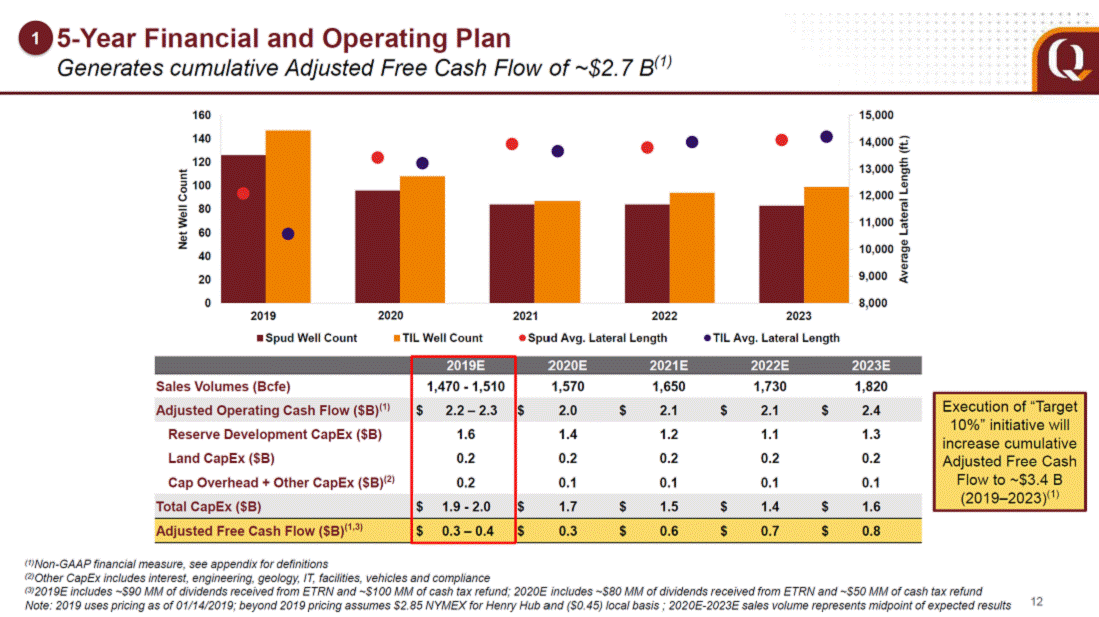
The Next Wave of Savings – “Target 10%” Initiative Transition to Manufacturing Mode 1 Q1 2019 – Evaluation 2019 – Execution 2020 – Full Realization Measures and Metrics in Place to Track Progress Savings Opportunities Identified and Quantified Realization Timeline and Milestones Adjusted Free Cash Flow(1) and Potential Upside with Capital Cost Reductions Evaluate and develop costs by 10% a plan to reduce capital 55 - 70 % 15 - 19 % 16 - 19 % 13 - 16 % 6 - 11 % 7 % Identify process improvements and additional cost reductions without sacrificing long-term asset value Anticipate cost savings from changes to: Materials and services sourcing and Water related processes Portfolio and schedule optimization Increased operating efficiencies contracting 2019E 2020E 2021E 2022E 2023E 19 - '23 Cum. Adjusted FCF(1) Yield(2) Base Base + "Target 10%" (1)Non-GAAP financial measure, see appendix for definition (2)Based on EQT market cap as of 12/31/2018. Adjusted FCF yield ranges shown represent base adjusted FCF at the low end and adjusted FCF assuming a 10% reduction in capital costs at the high end 13 $ 2.7 $ 0.7 $ 0.8 $ 0.6 $ 0.3 $ 0.3

Committed to Mitigating Curtailments 1 Full realization of benefits expected by year-end 2020 Example: Single Well Wellhead Constraints(1) Minimize adjacent operations and resulting operational reductions 1,400 1,200 1,000 800 600 400 200 - ~5% of volumes deferred to subsequent months through 18 months of production Uncurtailed Production (2) Curtailed Production Reduce concentration of activity oversupplied gathering systems on Actively pursue midstream solutions 1 2 3 4 5 6 7 8 9 10 11 12 13 14 15 16 17 18 19 20 21 22 23 24 Months on Production Example: Single Pad System Constraints 2019 Portfolio Curtailment (Bcfe) 350 20 300 System constraints 250 Operational Reductions Incremental Production 30 170 Bcfe; ~10% of ‘19 production 75 200 Wellhead Constraints 150 Fuel & LUF 100 Back Off 45 50 Base Production - 7/1 7/8 7/15 7/22 7/29 8/5 8/12 8/19 8/26 9/2 9/9 9/16 9/23 14 (1)Based on a 12,000 lateral foot Marcellus well; curtailed well produces at 18 MMcfe/d (1.5 Mcfe/d/ft) (2)Full-life curtailed type curve has been published at ir.eqt.com MMcf/d MMcf/mo Targeting Improvement

New Chief Operating Officer and Board Committee Focus on capital efficiency and operational excellence 1 Chief Operating Officer Search underway for new external COO Identifying shortlist of highly qualified candidates Expect to have new COO in-place by the end of Q1 2019 Will work with CEO and Senior Management to drive significant and timely improvements Operating and Capital Efficiency Board Committee 4th Formed during December Board Meeting Composed of four experienced former upstream executives Tasked with ongoing review of operations and capital deployment 15

Restructuring and Early Cost Reductions Annual administrative and development cost reductions of ~$100 MM 2 Performed intensive internal review of corporate overhead and identified quick win development cost efficiencies Approximately $50 MM of annual cash savings related to workforce reductions, removal of management layers, and reduced contractor expenses Operational process improvement initiatives and other capital cost reductions will reduce development costs by an additional ~$50 MM annually 16 These early wins result in ~$100 MM in annual cost reductions

Reduce Leverage and Return Capital to Shareholders 3 B(1) 19.9% equity stake in Equitrans Midstream (ETRN) worth $1.0 Adjusted Free Cash Flow(5) Yield – EQT vs. Marcellus Peers(2,3) Monetization of ETRN stake could reduce leverage(4) from 2.2x to 1.8x at current ETRN share price(1) 20 % 15 % 10 % Monetization paths include swap or outright sale tax free debt-for-equity 5 % 0 % (5)% $2.7 B of 5-year cumulative Adjusted Free Cash Flow(5), which implies ~50% of market (10)% 2019E 2020E 2021E 2022E 2023E cap(1) available to return to shareholders EQT "T“Taargrgeet t1100%%PIlnaintia" tive” Average of Marcellus Peers Low Leverage – EQT vs. Marcellus Peers(2) Investment grade rating at all three agencies Leverage(4) 3.7x 3.4x 3.4x Strong liquidity and low leverage $2.5 B revolver 1.8x (1)ETRN and EQT share price as of 12/31/2018 (2)Peers: AR, COG, CNX, GPOR, SWN and RRC (3)EQT is Adj. FCF. Peer FCF is CFFO less CapEx based on consensus Bloomberg estimates Peer 1 Peer 2 Peer 3 Peer 4 EQT Peer 5 EQT PF Peer 6 (4)EQT’s leverage calculated as EQT’s estimated 12/31/2018 Net Debt divided by EQT’s forecasted 2019 Adjusted EBITDA. Adjusted EBITDA is a non-GAAP financial measure, see appendix for definition. Net Debt means consolidated total debt, less consolidated cash and cash equivalents. Peer leverages are calculated using 9/30/2018 Net Debt divided by consensus analyst estimates of 2019 EBITDA per Bloomberg. AR and CNX consolidated Net Debt and EBITDA estimates are adjusted to exclude Net Debt and EBITDA estimates for AM and CNXM, respectively (5)Non-GAAP financial measure, see appendix for definition 17 2.2x2.2x2.0x 0.6x
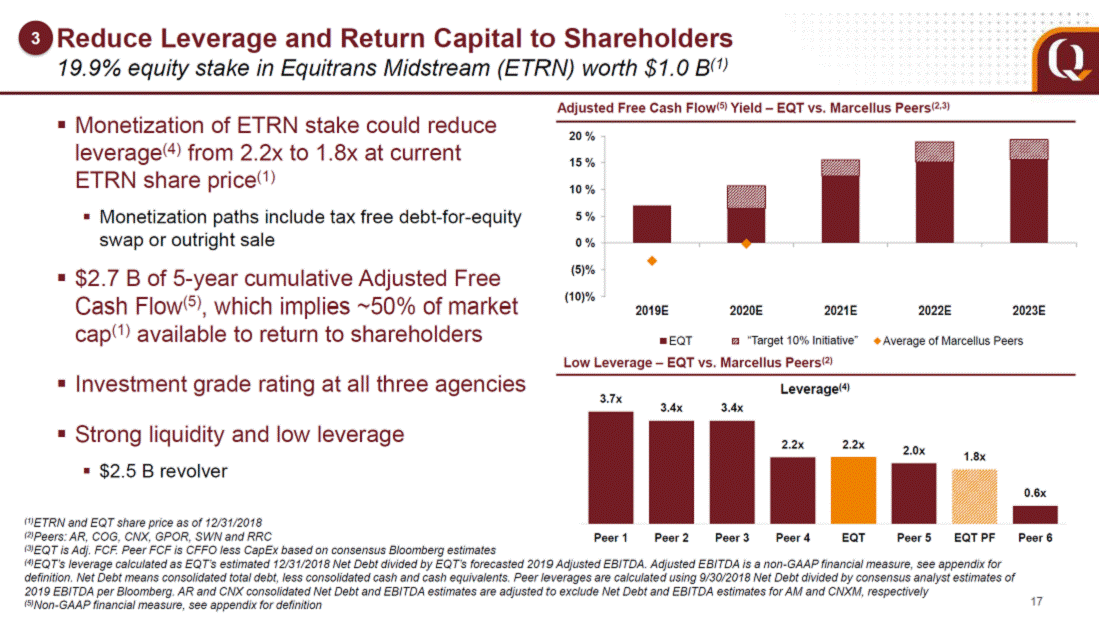
Rice Claims vs. The Facts No incremental free cash flow EQT to drill 91 PA Marcellus wells at 13,200’ average service market capitalized by EQT, artificially deflating $ / foot metric 18 The Facts Not practical given capacity and acreage portfolio; lateral length Ignores their own historical results and today’s oilfield Fails to account for EQT’s footprint, infrastructure and produced water dynamics No EUR uplift exists between EQT’s wells at 880’ spacing and the Rice 1,000’ claim Rice expensed many well cost components that are No incremental FCF vs. EQT plan Rice Claims All development activity focused in the PA Marcellus; 150 wells at 12,000’ average lateral length Can deliver uniform well costs of $750 / foot 100% pipeline delivered fresh water a key driver of well cost performance Increasing well spacing from 750’ to 1,000’ results in a 10% EUR uplift and 10% less wells Lower D&C $ / foot = Higher FCF +$400 - $600 MM FCF vs. EQT Plan

The New EQT: Strong Fundamentals to Deliver Shareholder Value World-class asset base, sustainable free cash flow and financial strength (1)Assumes 1,000’ spacing and 12,000’ lateral (2)Non-GAAP financial measure, see appendix for definition (3)Based on EQT’s estimated 12/31/2018 Net Debt divided by forecasted 2019 Adjusted EBITDA. Adjusted EBITDA is a non-GAAP financial measure, see appendix for definition. Net Debt means consolidated total debt less consolidated cash and cash equivalents (4)ETRN share price as of 12/31/2018 19 World-Class Asset Base Leading U.S. natural gas producer at >4.0 Bcfe per day 680,000 core net Marcellus acres / 1,950 undeveloped locations(1) / 15-20 year drilling inventory Contiguous acreage position allows for longer laterals and efficient long-term development Sustainable Free Cash Flow Evolution of strategic intent: volume growth FCF & returns Current plan generates Adjusted Free Cash Flow(2) of ~$350 MM in 2019, $2.7 B+ 2019-2023 Execute plan and transition to stable operations to drive development and cost efficiencies Falling capital requirements with moderate growth, high-graded wells, shallower base declines, and volume curtailment mitigation Financial Strength Investment grade credit ratings Low leverage of 2.2x Net Debt / Adjusted EBITDA(3) 19.9% retained equity stake in Equitrans Midstream worth $1.0 B at current share price(4)

Appendix A: In-Depth Analysis of The Rice Assertions 20

EQT Has Conducted a Deep Dive Analysis We disagree with the Rice assertions The Rice Claims After careful analysis, the Rice claims… Ignore current market conditions Are built on a small subset of wells Neglect asset specific operational dynamics Fail to account for key well cost components Lack a detailed plan for execution 21 Conversely, New EQT Management’s plan is transparent and achievable Laser-focused on cost reductions and operating efficiencies Unlocks free cash flow through initiatives that are already underway The Rice claim of $400 – $600 MM of annual incremental free cash flow is fundamentally flawed
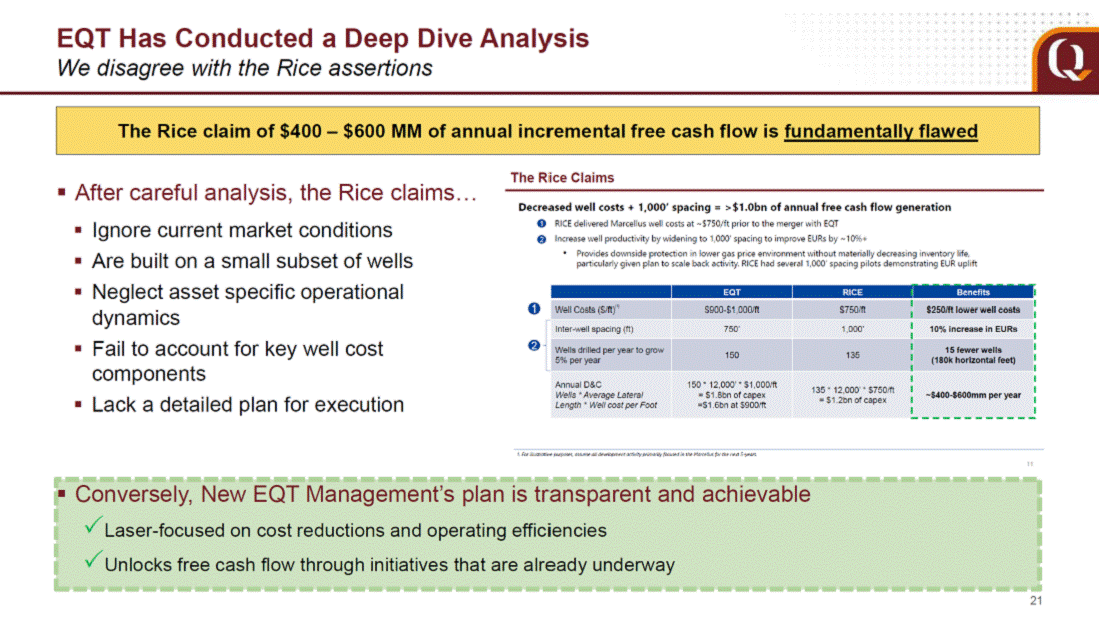
Reconciling the Rice ‘Headline’ Free Cash Flow Claims to EQT’s Plan Rice vs. EQT free cash flow profiles are similar when adjusted on a directly comparable basis 1 2 3 4 Rice Incremental Free Cash Flow Claim vs. EQT Plan Incremental Free Cash Flow vs. EQT Plan 1 2 3 4 5 22 Rice Claims The Facts All development activity focused in the PA Marcellus; 150 wells at 12,000’ average lateral length Not practical given capacity and acreage portfolio; EQT to drill 91 PA Marcellus wells at 13,200’ average lateral length Can deliver uniform well costs of $750 / foot Ignores their own historical results and today’s oilfield service market 100% pipeline delivered fresh water a key driver of well cost performance Fails to account for EQT’s footprint, infrastructure and produced water dynamics Increasing well spacing from 750’ to 1,000’ results in a 10% EUR uplift and 10% less wells No EUR uplift exists between EQT’s wells at 880’ spacing and the Rice 1,000’ claim Lower D&C $ / foot = Higher FCF Rice expensed many well cost components that are capitalized by EQT, artificially deflating $ / foot metric Multiple scenarios where the Rice plan could deliver free cash flow below EQT’s plan 5 Rice Adjusted Potential Incremental Adjustment
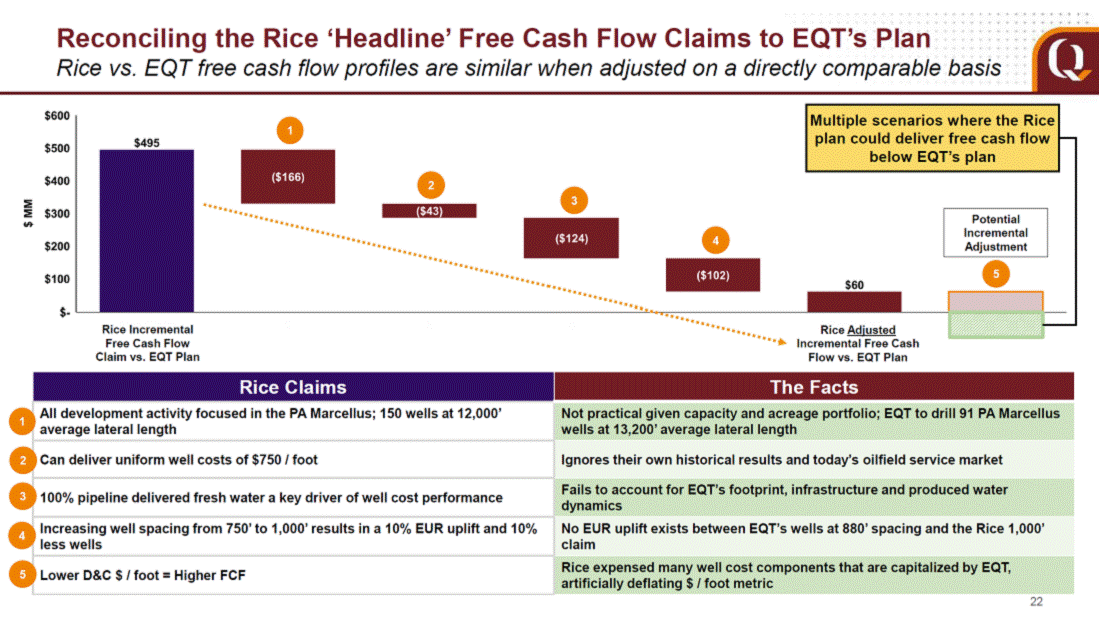
Digging into the Rice $750 / ft. Well Cost Claim 2 Ignores rapid service cost inflation and assumes 100% fresh water delivery 3 Costs (All-In) $755 $750 ~$870/ft. for 13,200’ 100% fresh water delivery 2019 PA period were $695/ ft. of $875/ft. for FY 2017 — Geographic footprint Adjusted by $40/ft. laterals expected service cost inflation construction costs — Produced water (750’ to 880’) adds 23 $ per foot $880 $860 vs. $865 $790 2 3536 Lateral Length: 9,200’ 9,200’ 8,200’ 13,200’ 13,200’ 13,200’ Spacing: 1,000’ 750’ 750’ 750’ 750’ 750’ Water Delivery: 100% piped 100% piped 100% piped 100% piped 55% piped / 45% trucked 55% piped / 45% trucked Lower service cost Rapid service cost Cost normalized to Adjusted to account for EQT’s 2019 PA environmentincreases in 2H 201713,200 lateral feetEQT’s mix of water usageMarcellus D&C costs — Matches EQT’s(spuds) planned at EQT’s costs for this Rice forecasted costsdevelopment plannot achievable given ourand 880’ spacing for average ~8,900 ft.— Cited 10-15%— Existing infrastructurefor pad and facility dynamics Dynamic applies to any operator of these assets Increase in EQT’s frac size with wider spacing $45/ft. ($910/ft. total) Rice Current Claim 1H 2017 Rice Actual Results 2H 2017 Rice Actual Results Rice Adjusted for Lateral Lengths Rice Adjusted for Water Usage and Delivery EQT 2019 Planned Well An internal review suggests that comparative PA Marcellus $/ft. costs are much closer than the Rice claim

Comparing the Rice $750 / ft. Well Cost Claim to EQT 2 comparison(1) EQT vs. Rice: PA Marcellus $ / foot well costs $1,000 $900 $800 $700 $600 $500 $400 $300 $200 $100 $0 $1,000 $900 $800 $700 $600 $500 $400 $300 $200 $100 $0 Average: $$775535/ /Fft. Average: $$669945 / Fftt. Well Name Well Name 24 (1) EQT and Rice actual results – 1H 2017 (ranked by total cost) $ per foot $ per foot EQT 1H 2017 TILs Rice 1H 2017 TILs Actual results reveal Rice’s 1H 2017 well costs were above EQT’s

Oil Field Service Cost Inflation Accelerated in 2H 2017 2 Service costs were on the rise and widely accepted US Rig Count and Drilling and Completion Service (DCS) Cost Inflation(1,2) Snapshot of Rice Energy February 2017 Analyst Presentation 120 2,000 1,800 1,600 1,400 1,200 1,000 800 600 400 200 0 115 110 105 100 95 90 85 Q1 14 Q1 15 Q1 16 Q1 17 Q1 18 (1)Source: Goldman Sachs, Baker Hughes, and Spears and Associates (2)Spears and Drilling and Completion Services (DCS) Marcellus Index – Well costs indexed to 100 based on drilling and completion services as of Q1 2008. Price change is calculated for each well profile covered by the survey which reflects the weighted average price change for each component of the well’s cost. Prices for services based on pricing at quarter end. 25 Marcellus DCS Index US Rig Count Implies market expectation of 17-25% DCS IndexU.S. Rig Count Activity consistently increased after bottoming out in early 2016 ~25% DCS Inflation …nor with current market realities $750/ft. does not align with Rice’s historical performance…

Why Is Fresh and Produced Water Usage Important? 3 Critical implications for well costs and trickle-down effect on operations The Rice publicized results are based on a small subset of EQT produces ~70,000 bbls a day of produced water – ~$4.00/bbl PA Marcellus Completion Operations Geographic proximity, physical water access, infrastructure Rice Claim 26 Produced Water Delivery ~35% ~$7.25/bbl Fresh Water Delivery ~55% ~$2.50/bbl ~10% wells utilizingfor completions Much cheaper from a capitalized D&C perspective Not practical across EQT’s larger geographic footprint the water has to go somewhere Any operator of these assets must move this water to disposal or frac operations Most cost-efficient treatment is recycling Not utilizing produced water negatively impacts operating costs and water handling costs govern EQT’s water usage mix EQT’s geographic footprint and produced water dynamics require an incremental ~$1.75/bbl or ~$70 / ft. vs. 100%-piped fresh water 100% pipeline-delivered fresh water EQT’s % Mix of Water Usage in the PA Marcellus Water usage and associated cost treatment must be considered when analyzing comparative well costs
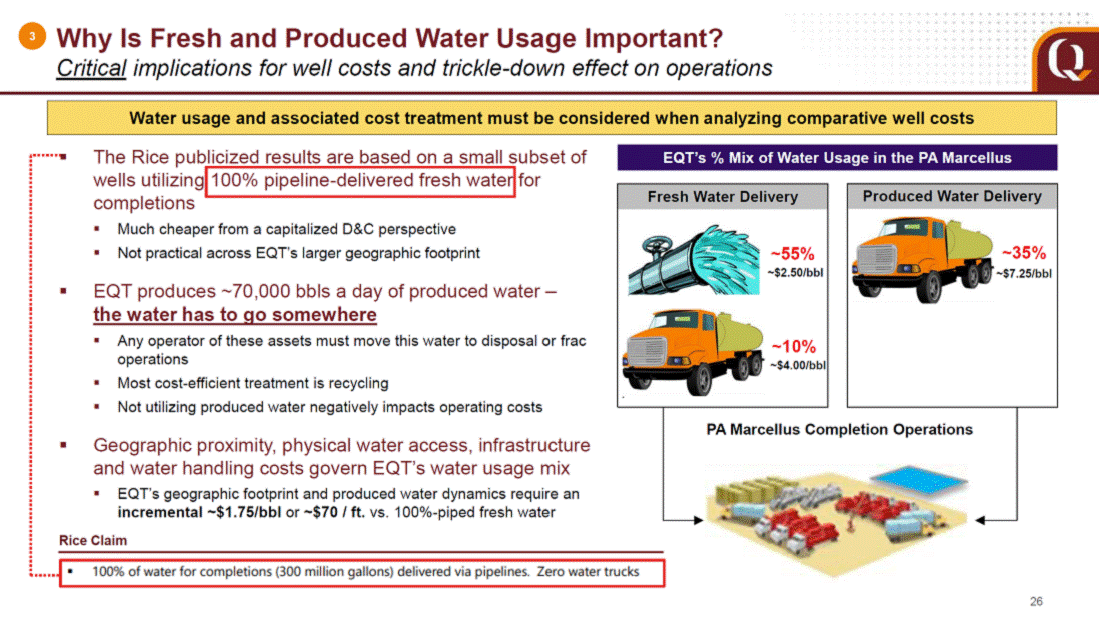
Optimizing Well Spacing to Maximize Reservoir Development and Efficiency 4 Rice claims that they can achieve 10% production uplift compared to EQT’s current plan Cumulative Gas Production – Dry Marcellus Curve The Rice plan contemplates moving from 750’ to 1,000’ spacing without increasing frac size 19.0 We also view wider well spacing as the optimal development approach and we are moving to 1,000’ over the next two years 17.0 15.0 EQT firmly believes that maximizing asset value is only achieved through a corresponding increase in frac size 13.0 EQT conducts extensive testing on spacing intervals and closely monitors and evaluates well performance Simply increasing from 750’ to 1,000’ without changing design results in sub-optimal development 11.0 9.0 7.0 Increased frac size results in incremental initial outweighed by higher EUR’s and returns capital, 5.0 Year 1 Year 2 Year 3 Year 4 Year 5 Historical Average Spacing (ft.) - PA Marcellus Wells (Spud) EQT 1,000’ 880 840 EQT 880’ Rice 1,000’ 2016 2017 2018 2019E 27 Bcf Rice’s claim = negative production impact 740760 Cumulative Production Uplift vs. 750’ Spacing 11% 18% 20% 21% 22% 7% 9% 10% 11% 12% 6% 7% 8% 9% 10% EQT Marcellus Dry, 1000 ft. Spacing, Optimized EQT Marcellus Dry, 880 ft. Spacing Rice 1000 ft. Spacing + 10%, Not Optimized EQT Marcellus Dry, 750 ft. Spacing , Optimized Wider well spacing without increased frac design will require more wells and capital to achieve same production over 5 years, destroying value The Rice claim actually results in a negative production impact

Analysis Fails to Consider Both Sides of the Equation 5 LOE vs. Capital Costs - differing treatment of well cost components Rice captured various well LOE that EQT capitalizes Flowback operations Land projects Construction projects related costs in 1,600 1,400 1,200 1,000 800 600 400 200 - 1,490 $120 $104 $100 $80 $60 $40 Different accounting treatment evident in $20 $-the significantly higher LOE carried by Rice Rice 2017 Guidance EQT 2019 Guidance Rice 2017 Guidance EQT 2019 Guidance EQT’s 2019E aggregate LOE than Rice’s 2017 guidance is only marginally higher Rice 2017 Guidance Midpoint EQT 2019 Guidance Midpoint $ $ 0.17 0.07 1.5 (Tcfe) $ 150 ($MM) 28 Production (Bcfe) LOE ($ MM) Implied Annual Incremental Costs EQT 2019 Production Guidance Implied Incremental Operating Costs $0.10 Incremental annual cost could be as high as $150 MM This is not included in the Rice D&C analysis Lease Operating Expenses$/Mcfe $82 483 … but only ~25% more expense >300% of Rice’s production… A simple D&C cost analysis misses important additional cost components

Historical Drilling Performance in the Marcellus and Upper Devonian Economic optimization and geologic variation across asset drive EQT’s drilling program Historical EQT MRC/UD Horizontal Drilling Performance(1) EQT’s rig program has multiple considerations: 400k SW Peer Avg. (2) FOP/Rig/Year ms commitments, resulting in more rig (1)Excludes vertical section drilled by horizontal rigs (2)Sourced from 12/09/2018 Rice Presentation (3)Midpoint of guidance 29 Horizontal FOP 300k 200k 100k 0k Rice Clai 293k 249k 226k 203k 201620172018 # of Horizontal (Hz) Rigs 2019E 7(3) TIME & MOVEMENT Consideration: Effect: Large geographic footprint Geologic structure results in rate of penetration variability Expansive operational activity results in longer rig move duration Maximizing # of wells per pad Larger well step-outs result in increased Hz drilling days NPV Optimization Shrink duration between capital deployment and cash flow generation Optimizing gathering capacity and moves Management of lease expiration profile EQT has consistently performed at or above the peer average on a much larger and more operationally diverse geographic footprint.

Rice vs. EQT Free Cash Flow Profile Bridging the gap planned 2019 Adjusted Incremental FCF $ 329 Reduction to Claim $ (166) 1 D&C $/ft. # of Wells Length (ft) ($MM) EQT $ 950 13,200 91 $ 1,141 Adjusted Incremental FCF $ 286 Reduction to Claim $ (43) 2 Length (ft) ($MM) Adjusted Incremental FCF $ 162 Reduction to Claim $ (124) 3 Length (ft) ($MM) EQT $ 910 13,200 91 $ 1,093 Adjusted Incremental FCF $ 60 Reduction to Claim $ (102) 4 5 30 LOE vs. Capital treatment of certain well costs could further reduce claim by as much as $150 MM Rice$86013,200 91 $1,033 No 10% EUR uplift or well count reduction D&C $/ft.Lateral# of WellsCapEx Level setting well costs to be comparable D&C $/ft.Lateral# of WellsCapEx EQT Rice $910 $860 13,20091$1,093 13,20082$931 Rice $790 13,20082$855 Inflation and lateral length normalization LateralCapEx Adjust to EQT’s activity level Late ralCapEx D&C $/ft.Le ngth (ft) # of We lls($MM) EQT$95012,000150$1,710 Rice$75012,000135$1,215 Rice Claim e d Incre m e ntal FCF$495 LateralCapEx D&C $/ft.Length (ft)# of Wells($MM) EQT$950 Rice$750 13,20091 13,20082 $1,141 $812 The Rice vs. EQT free cash flow profiles are similar when adjusted on a directly comparable basis

Appendix B

2019 Guidance Flow(1) ~$350 MM of Adjusted Free Cash 32 (1)Non-GAAP financial measure, see appendix for definitions Full-Year 2019 Production Total production sales volume (Bcfe) Liquids sales volume, excluding ethane (Mbbls) Ethane sales volume (Mbbls) Total liquids sales volume (Mbbls) 1,470-1,510 8,130-8,330 5,780-5,980 13,910-14,310 Resource Counts Marcellus / Utica Rigs Top-hole Rigs Frac Crews 6-8 2-4 5-7 Unit Costs ($/Mcfe) Gathering Transmission Processing LOE, excluding production taxes Production taxes SG&A $0.55-$0.57 $0.48-$0.50 $0.08-$0.10 $0.06-$0.08 $0.05-$0.07 $0.11-$0.13 Average Differential ($/Mcf) ($0.45)-($0.25) Adjusted EBITDA ($B)(1) 2.4-2.5 Adjusted Operating Cash Flow ($B)(1) Capital Expenditures ($B) 2.2-2.3 1.9-2.0 Adjusted Free Cash Flow ($B)(1) 0.3-0.4
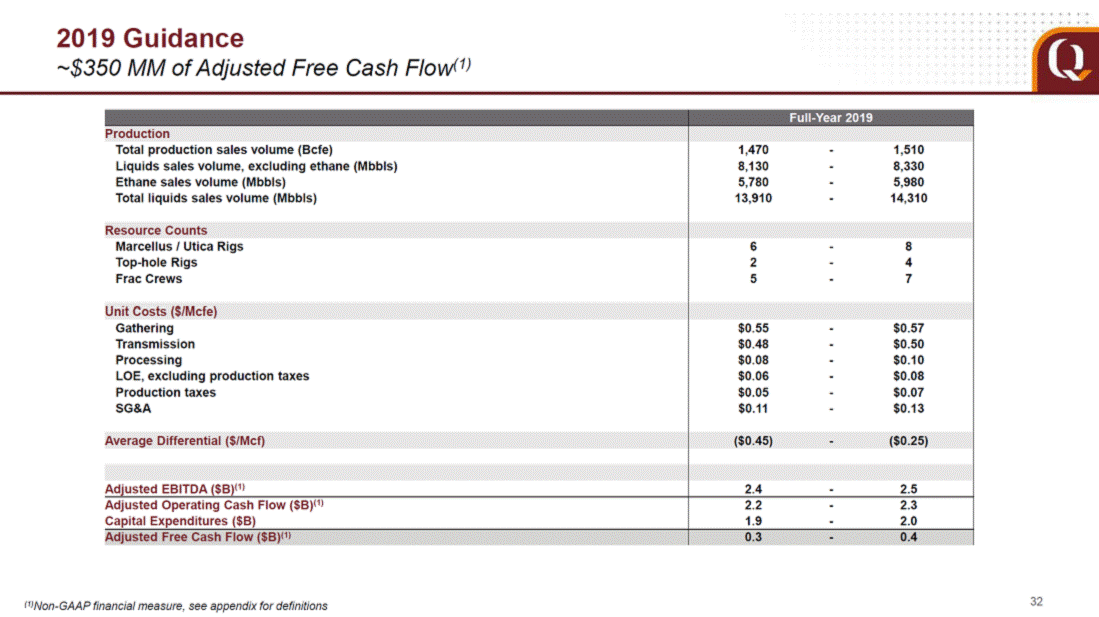
Detailed 2019E Activity 2019 $/ft Details 2019 Total CapEx Details CapEx ($MM) 33 (1)Other Non-D&C CapEx includes pad construction and pad facility costs Total Reserve DevelopmentPAWVOH CapEx ($MM)MarcellusMarcellusUtica Total Spud$60$10$30 Horizontally Drilled$275$40$30 Completed$585$105$180 Turned-in-Line$70$15$30 $100 $345 $870 $115 Total D&C CapEx ($MM)$990$170$270 $1,430 Other Non-D&C CapEx ($MM)(1)$95$20$20 $135 Total Reserve Development$1,085$190$290 $1,565 2019EPAWVOH MarcellusMarcellusUtica Total / Average # of Net Wells Total Spud911520 Horizontally Drilled1432616 Completed822722 Turned-in-Line1002423 126 185 131 147 Average Lateral Length (ft.) Average Spud13,2006,50011,200 Horizontally Drilled12,0006,80010,900 Completed11,6006,00012,500 Turned-in-Line11,3006,20012,200 12,100 11,200 10,600 10,600 D&C Cost per Lateral Foot ($/ft.) Average Spud$50$98$134 Horizontally Drilled$162$229$170 Completed$616$648$650 Turned-in-Line$62$101$107 $65 $170 $624 $75 Total D&C Cost per Foot ($/ft.)$890$1,075$1,060 $934

Long Term Value Creation 5-year Annual Volumes and Decline Rates 5-year Adjusted Free Cash Flow(1) and Adjusted EBITDA(1) Adj. FCF Adj. EBITDA 2,000 35% $3.0 30% 1,600 $2.5 25% $2.0 1,200 20% $1.5 15% 800 $1.0 10% 400 $0.5 5% - 0% $0.0 2018 2019 2020 2021 2022 2023 2019(2) 2020 2021 2022 2023 (1)Non-GAAP financial measure, see appendix for definition (2)Midpoint of guidance range 34 Annual Volumes (Bcfe) YE 2018 Exit Rate Decline $B 16% 28% 20% 15% 12% 11% 14% 17% 22% 32%

Firm Transportation Portfolio Provides access, stability and opportunity Diversity of delivered markets provides significant commercial optionality Portfolio offers price stability by accessing highly liquid markets Assets directly access markets which represent ~85% of expected U.S. natural gas demand growth ISD 16% 35 Note: Total transported volumes differ slightly from quantities shown on map due to other local transport contracts and contract expiration timing Transmission Costs 2019E 2020E Transportation Bcfe/d$/Mcfe Bcfe/d$/Mcfe Transport volumes Local deliveries 2.9$0.52 1.1$-4.1$0.60 0.2$-Total firm deliveries 4.1$0.37 4.3$0.59 Equitrans transmission $0.12 $0.13 Total transmission $ 0.48 - 0.50 $ 0.71 - 0.73 93933,030,000D0 tDht/hd/dEQT552200,,000000 DDtthh//dd Market Mix 2019E 2020E 2021E 2022E 2023E TETCO M2 31% 7% 2012% 20% TETCO M3 12% 11% 10% 10% 9% Midwest 25% 23% 22% 21% 20% Gulf 32% 31% 29% 27% 26% SE 0% 28% 27% 26% 25% 2020 ISD

Risk Management NYMEX Hedge position as of December 31, 2018 Volume (MMDth) Average Price ($/dth) 699 2.96 452 2.82 303 2.78 136 2.75 61 2.74 $ $ $ $ $ Volume (MMDth) Average Short Strike Price ($/dth) 304 3.43 89 3.29 55 3.23 40 3.19 26 3.17 $ $ $ $ $ Volume (MMDth) Average Long Strike Price ($/dth) 0 – 0 – 42 2.97 0 – 10 2.71 $ $ $ $ $ Volume (MMDth) Average Price ($/dth) 0 – 0 – 0 – 123 3.01 7 2.87 $ $ $ $ $ 36 *The difference between the fixed price and NYMEX are included in average differential on the Company’s price reconciliation. 20192020202120222023 Fixed Price Sales* Puts - Net Long Calls - Net Short 20192020202120222023 Swaps

YTD(1) Unit Cost Comparison – Q3 2018 Peer-leading unit costs for LOE, G&A Lease Operating Expense ($/Mcfe)(2) General & Administrative ($/Mcfe) Peer Mean (excl Peer 5): $0.16 $0.93 $0.26 EQT Peer 1 Peer 2 Peer 3 Peer 4 Peer 5 EQT Peer 1 Peer 5 Peer 2 Peer 4 Peer 3 (1)Peers include AR, CNX, COG, RRC, SWN (2)Peer 5 classifies its gathering, transportation & processing costs as part of LOE 37 Peer Mean: $0.20 $0.20 $0.22 $0.19 $0.12 $0.11 $0.17 $0.21 $0.14 $0.10 $0.08

Cautionary Statements EQT Corporation (NYSE: EQT) EQT Plaza 625 Liberty Avenue, Suite 1700 Pittsburgh, PA 15222 Blake McLean – Senior Vice President, Investor Relations and Strategy – 412.395.3561 The Securities and Exchange Commission (SEC) permits oil and gas companies, in their filings with the SEC, to disclose only proved, probable and possible reserves that a company anticipates as of a given date to be economically and legally producible and deliverable by application of development projects to known accumulations. We use certain terms in this presentation, such as “EUR” (estimated ultimate recovery) and total resource potential, that the SEC’s rules strictly prohibit us from including in filings with the SEC. We caution you that the SEC views such estimates as inherently unreliable and these estimates may be misleading to investors unless the investor is an expert in the natural gas industry. We also note that the SEC strictly prohibits us from aggregating proved, probable and possible (3P) reserves in filings with the SEC due to the different levels of certainty associated with each reserve category. Disclosures in this presentation contain certain forward-looking statements within the meaning of Section 21E of the Securities Exchange Act of 1934, as amended, and Section 27A of the Securities Act of 1933, as amended. Statements that do not relate strictly to historical or current facts are forward-looking. Without limiting the generality of the foregoing, forward-looking statements contained in this presentation specifically include the expectations of plans, strategies, objectives and growth and anticipated financial and operational performance of EQT Corporation and its subsidiaries (EQT), including guidance regarding EQT’s strategy to develop its reserves; drilling plans and programs (including the number, type, depth, spacing, lateral lengths, and locations of wells to be drilled, number of frac crews and number and type of rigs); projected natural gas prices, liquids production, liquids price impact, basis, premium and average differential; total resource potential, reserves and EUR; projected EQT and third party production sales volumes and growth rates (including liquids sales volumes and growth rates); internal rate of return (IRR), compound annual growth rate (CAGR) and expected after-tax returns per well; technology (including drilling and completion techniques); projected drilling and completions (D&C) costs, other well costs, unit costs and G&A expenses; projected reductions in expenses and capital and well costs and projected frac stage lengths, projected market mix; infrastructure programs; the cost, capacity, and timing of regulatory approvals; acquisition transactions; the projected capital efficiency savings and other operating efficiencies associated with EQT’s shift to a steady operating cadence and EQT’s ability to achieve such efficiencies; EQT’s ability to mitigate curtailments; the projected capital efficiency savings and other operating efficiencies and synergies resulting from EQT’s acquisition of Rice Energy Inc. (Rice); EQT’s ability to achieve the anticipated synergies and efficiencies from its acquisition of Rice; monetization transactions, including asset sales, joint ventures or other transactions involving EQT’s assets; EQT’s ability to achieve the anticipated operational, financial and strategic benefits of the spin-off of Equitrans Midstream Corporation (ETRN) from EQT; the timing and structure of any dispositions of EQT's 19.9% retained common stock of ETRN and EQT's planned use of the proceeds from any such dispositions; the amount and timing of any repurchases of EQT’s common stock, including whether EQT will institute a share repurchase program; dividend amounts and rates; projected cash flows, including the ability to fund the 2019 drilling program through cash from operations; projected Free Cash Flow, Adjusted Free Cash Flow, Adjusted Operating Cash Flow, net marketing services revenue, and net income attributable to noncontrolling interests, including EQT’s ownership of 19.9% of ETRN’s common stock; projected capital contributions and capital expenditures; projected Adjusted EBITDA; liquidity and financing requirements, including funding sources and availability; EQT’s ability to maintain or improve its credit ratings, leverage levels and financial profile; potential future impairments of EQT’s assets; EQT’s hedging strategy; the effects of government regulation and litigation; and tax position and the expected impact of changes to tax laws. These forward-looking statements involve risks and uncertainties that could cause actual results to differ materially from projected results. Accordingly, investors should not place undue reliance on forward-looking statements as a prediction of actual results. EQT has based these forward-looking statements on current expectations and assumptions about future events. While EQT considers these expectations and assumptions to be reasonable, they are inherently subject to significant business, economic, competitive, regulatory and other risks and uncertainties, many of which are difficult to predict and beyond EQT’s control. The risks and uncertainties that may affect the operations, performance and results of EQT’s business and forward-looking statements include, but are not limited to, those set forth under Item 1A, “Risk Factors,” of EQT’s Form 10-K for the year ended December 31, 2017, as filed with the SEC and as updated by any subsequent Form 10-Qs. Any forward-looking statement speaks only as of the date on which such statement is made and EQT does not intend to correct or update any forward-looking statement, whether as a result of new information, future events or otherwise. 38

Non-GAAP Financial Measure Adjusted Operating Cash Flow, Free Cash Flow and Adjusted Free Cash Flow As used in this presentation, Adjusted Operating Cash Flow is defined as EQT’s net cash provided by operating activities less changes in other assets and liabilities plus dividends received from Equitrans Midstream Corporation (ETRN). Free Cash Flow is defined as EQT’s net cash provided by operating activities less changes in other assets and liabilities, less accrual-based capital expenditures. Adjusted Free Cash Flow is defined as Free Cash Flow plus dividends received from ETRN. Adjusted Operating Cash Flow, Free Cash Flow and Adjusted Free Cash Flow are non-GAAP supplemental financial measures that management and external users of EQT’s consolidated financial statements, such as industry analysts, lenders and ratings agencies use to assess EQT’s liquidity. EQT believes that Adjusted Operating Cash Flow, Free Cash Flow and Adjusted Free Cash Flow provide useful information to management and investors in assessing the impact of EQT’s ability to generate cash flow in excess of capital requirements and return cash to shareholders. Adjusted Operating Cash Flow, Free Cash Flow and Adjusted Free Cash Flow should not be considered as alternatives to net cash provided by operating activities or any other measure of liquidity presented in accordance with GAAP. EQT is unable to project net cash provided by operating activities for any of the forecasted periods presented and has not provided a related reconciliation of projected Adjusted Operating Cash Flow, Free Cash Flow and Adjusted Free Cash Flow to projected net cash provided by operating activities, the most comparable financial measure calculated in accordance with GAAP, because net cash provided by operating activities includes the impact of changes in operating assets and liabilities. Changes in operating assets and liabilities relate to the timing of EQT’s cash receipts and disbursements that may not relate to the period in which the operating activities occurred, and EQT is unable to project these timing differences with any reasonable degree of accuracy to a specific day in advance of finalizing its financial results for the applicable period. 39

Non-GAAP Financial Measure Adjusted EBITDA As used in this presentation, Adjusted EBITDA is defined as net income plus interest expense, income tax expense, depreciation depletion and amortization expense, amortization of intangible assets, long-lived asset and goodwill impairments, lease impairments and expirations, loss (gain) on derivatives not designated as hedges, net cash settlements received (paid) on derivatives not designated as hedges, premiums received (paid) for derivatives that settled during the period, and unrealized loss (gain) on EQT’s investment in ETRN. Adjusted EBITDA is a non-GAAP supplemental financial measure that management and external users of EQT’s consolidated financial statements, such as industry analysts, lenders and ratings agencies use to assess EQT’s earnings trends. EQT believes that Adjusted EBITDA is an important measure used by EQT’s management and investors in evaluating period-over-period comparisons of earnings trends. Adjusted EBITDA should not be considered as an alternative to EQT’s net income presented in accordance with GAAP. Adjusted EBITDA excludes the revenue impact of changes in the fair value of derivative instruments prior to settlement and other items that affect the comparability of results and are not trends in the ongoing business. Management utilizes Adjusted EBITDA to evaluate earnings trends because the measure reflects only the impact of settled derivative contracts and thus the income from natural gas is not impacted by the often-volatile fluctuations in fair value of derivatives prior to settlement. EQT has not provided projected net income or a reconciliation of projected Adjusted EBITDA to projected net income, the most comparable financial measure calculated in accordance with GAAP, because EQT does not provide guidance with respect to depletion and amortization expense beyond the current year, income tax expense, the revenue impact of changes in the projected fair value of derivative instruments prior to settlement or unrealized gains and losses on its investments in equity securities. EQT does not provide projections for its year-end reserves, as they are impacted by SEC prescribed pricing that is not known until the end of a given year, along with other factors such as drilling and completion costs in future periods. As reserves are a key component of the depletion calculation, EQT cannot project depletion and amortization expense within a reasonable range. Therefore, projected net income and a reconciliation of projected Adjusted EBITDA to projected net income, are not available without unreasonable effort. 40


